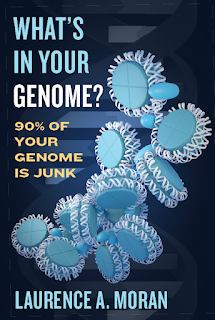John Mattick continues to promote the idea that he is leading a paradigm shift in molecular biology. He believes that he and his colleagues have discovered a vast world of noncoding genes responsible for intricate gene regulation in complex eukaryotes. The latest salvo was fired a few months ago in June 2023.
Mattick, J.S. (2023) A Kuhnian revolution in molecular biology: Most genes in complex organisms express regulatory RNAs. BioEssays:2300080. [doi: 10.1002/bies.202300080]
Thomas Kuhn described the progress of science as comprising occasional paradigm shifts separated by interludes of ‘normal science’. The paradigm that has held sway since the inception of molecular biology is that genes (mainly) encode proteins. In parallel, theoreticians posited that mutation is random, inferred that most of the genome in complex organisms is non-functional, and asserted that somatic information is not communicated to the germline. However, many anomalies appeared, particularly in plants and animals: the strange genetic phenomena of paramutation and transvection; introns; repetitive sequences; a complex epigenome; lack of scaling of (protein-coding) genes and increase in ‘noncoding’ sequences with developmental complexity; genetic loci termed ‘enhancers’ that control spatiotemporal gene expression patterns during development; and a plethora of ‘intergenic’, overlapping, antisense and intronic transcripts. These observations suggest that the original conception of genetic information was deficient and that most genes in complex organisms specify regulatory RNAs, some of which convey intergenerational information.
This paper is promoted by a video in which he explains why there's a Kuhnian revolution under way. This paper differs from most of his others on the same topic because Mattick now seems to have acquired some more knowledge of the mutation load argument and the neutral theory of evolution. Now he's not only attacking the so-called "protein centric" paradigm but also the Modern Synthesis. Apparently, a slew of "anomalies" are casting doubt on several old paradigms.
This is still a paradigm shaft but it's a bit more complicated than his previous versions (see: John Mattick's paradigm shaft). Now his "anomalies" include not only large numbers of noncoding genes but also the C-value paradox, repetitive DNA, introns, enhancers, gene silencing, the g-value enigma, pervasive transcription, transvection, and epigenetics. Also, he now seems to be aware of many of the arguments for junk DNA but not so aware that he can reference any of his critics.1 His challenges to the Modern Synthesis include paramutation which, along with epigenetics, violate the paradigm of the Moden Synthesis because of non-genetic inheritance.
But the heart of his revolution is still the discovery of massive numbers of noncoding genes that only he and a few of his diehard colleague can see.
The genomic programming of developmentally complex organisms was misunderstood for much of the last century. The mammalian genome harbors only ∼20 000 protein-coding genes, similar in number and with largely orthologous functions as those in other animals, including simple nematodes. On the other hand, the extent of non-protein-coding DNA increases with increasing developmental and cognitive complexity, reaching 98.5% in humans. Moreover, high throughput analyses have shown that the majority of the mammalian genome is differentially and dynamically transcribed during development to produce tens if not hundreds of thousands of short and long non-protein-coding RNAs that show highly specific expression patterns and subcellular locations.
The figure is supposed to show that by 2020 junk DNA had been eliminated and almost all of the mammalian genome is devoted to functional DNA—mostly in the form of noncoding genes. There's only one very tiny problem with this picture—it's not supported by any evidence that all those functional noncoding genes exist. This is still a paradigm shaft of the third kind (false paradigm, false overthrow, false data).
1. There are 124 references; Dawkins and ENCODE make the list along with 14 of his own papers. Most of the papers in my list of Required reading for the junk DNA debate are missing. The absence of Palazzo and Gregory (2023) is particularly noteworthy.
Palazzo, A.F., and Gregory, T.R. (2014) The Case for Junk DNA. PLoS Genetics, 10:e1004351. [doi: 10.1371/journal.pgen.1004351]>/p>


























